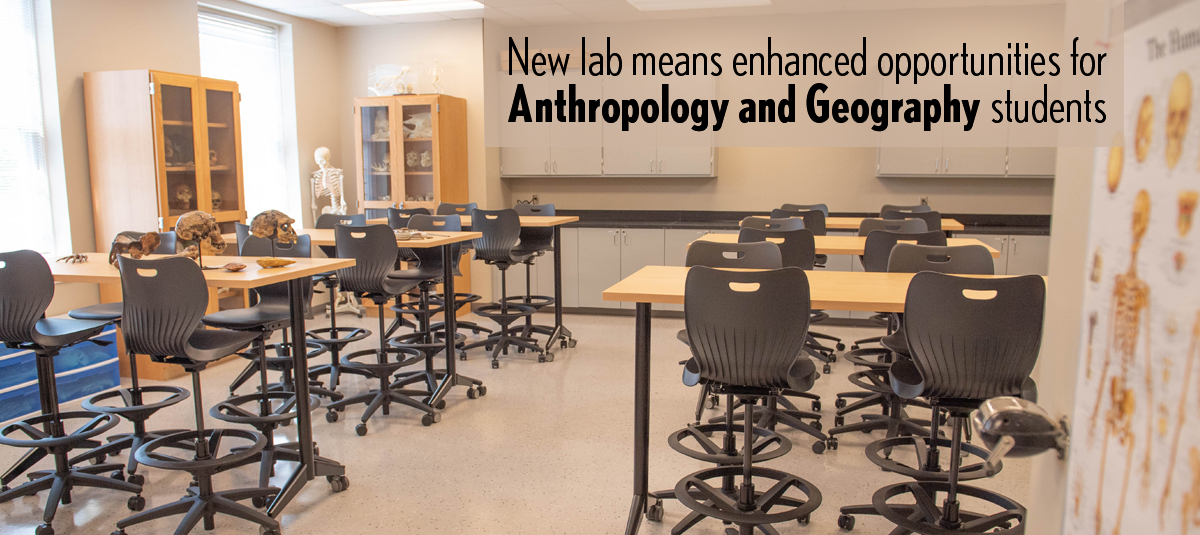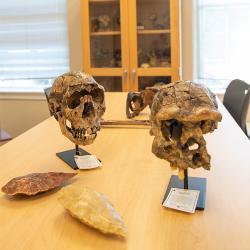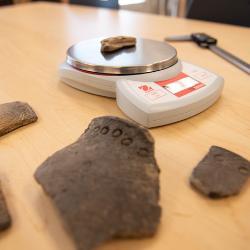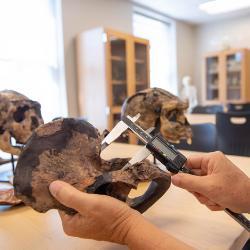
SNAPSHOT | FEBRUARY 1, 2021

CCU’s Department of Anthropology and Geography has recently gained a new space that not only transforms the learning process for students, but also offers a facility for research, interdisciplinary projects, and community building.
 The anthropology and geography lab, located in Prince 201, is a teaching space for classes ranging from Cultural Resource Management; to Primates, People and Prehistory; to Physical Geography; to Forests and People. Originally designed as an archaeology lab in the 1980s, the space was used for a variety of other purposes over the years until Carolyn Dillian, chair of the Department of Anthropology and Geography, made a case for a return to its original purpose.
The anthropology and geography lab, located in Prince 201, is a teaching space for classes ranging from Cultural Resource Management; to Primates, People and Prehistory; to Physical Geography; to Forests and People. Originally designed as an archaeology lab in the 1980s, the space was used for a variety of other purposes over the years until Carolyn Dillian, chair of the Department of Anthropology and Geography, made a case for a return to its original purpose.
“It’s designed perfectly for anthropology and geography: the work spaces, the sink, the storage – the overall space is designed specifically for what we do,” said Dillian.
Dillian said the lab is a game-changer in terms of teaching.
“It provides a really accessible and visible place for students to engage in classes that offer a hands-on experience with anthropology and geography,” said Dillian. “Students are working with archeological specimens and skeletal casts and sediments and trees, and they are really getting that experiential learning aspect in a space that is specifically designed for that kind of experiential learning.”
anthropology and geography,” said Dillian. “Students are working with archeological specimens and skeletal casts and sediments and trees, and they are really getting that experiential learning aspect in a space that is specifically designed for that kind of experiential learning.”
Faculty have been able to modify courses to adapt to new opportunities and possibilities in the classroom.
“Now we’re able to teach in a space where we can pull out specimens and view more things that get students physically engaged in the material they’re learning,” said Dillian. “It’s one thing to sit in a classroom and have me lecture, ‘This is the pottery of the American Southeast; here are some pictures’ but to actually sit in a lab and be able to get your hands on those artifacts and to analyze them, and to learn about them through that kind of experience, is much more valuable.”
Dillian also wants students to feel a sense of ownership in the space, so the lab’s weekly schedule includes time for students to work on projects, and for clubs – such as the Anthropology and Geography Club and SPROUT, which conducts sustainability projects on campus – to meet.
“We really want it to be a hub for our students,” said Dillian. “We’re setting aside time throughout the week for student drop-in hours, if they want to work on research. We can hold meetings and host seminars and guests – so we set aside time in that space to allow for the kind of activities that give our department some community building.”
 While the COVID pandemic has put a damper on the scale of its availability, the lab is still being used for classes in reduced capacity and hybrid formats.
While the COVID pandemic has put a damper on the scale of its availability, the lab is still being used for classes in reduced capacity and hybrid formats.
“We wanted to jump right in and have busy labs in that space, so that’s been disappointing, but we’re still holding classes,” said Dillian. “Students still come by during open hours, and say, ‘Can I pull out these specimens and look at them in person?’ So that’s been good, too. It’s one thing to study skeletal anatomy by looking at 3d images online, but it’s something else entirely to get your hands on those pieces. It’s giving students a chance to come in and at least explore.”
Dillian is grateful to the CCU Provost’s Office for providing for the use of the space and supporting the work of the department.





